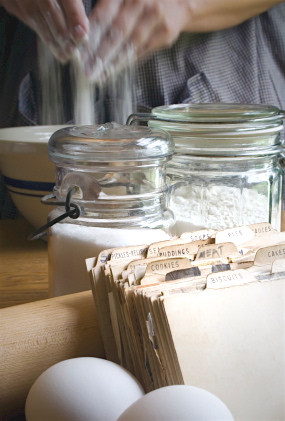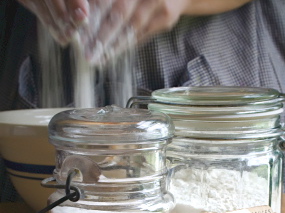
baking, l
(article, Catherine Bennett Dunster)
[%pageBreakSettings nobreak=true][%adInjectionSettings noInject=true] p(blue). Editor's note: Catherine Bennett Dunster wrote the Health+Food column from June 2007 to April 2008. "I was recently diagnosed with celiac disease after years of debilitating intestinal problems and multiple visits to my doctor. Now she's recommended a gluten-free diet, and I’m wondering if it’s possible to eat nutritiously without gluten." Congratulations on finally getting a diagnosis. Sadly, most people with celiac disease suffer the symptoms and their effects for many years before getting properly diagnosed. Once gluten intolerance is identified, however, there's an opportunity to put the troublesome symptoms to rest, and to eat well — without gluten. [%image baking float=right width=280 caption="Eating a GF diet doesn't mean giving up baking; it just means learning how to cook with new ingredients."] In her most recent (and thoroughly informative) edition of [%bookLink code=1894022793 "Gluten-Free Diet: A Comprehensive Resource Guide"], Shelley Case, a nutrition expert on celiac disease, writes that it’s difficult to diagnose celiac disease, “because of the broad range of symptoms that can vary from mild to severe or none at all. Individuals are often misdiagnosed with irritable bowel syndrome, lactose intolerance, fibromyalgia, chronic fatigue syndrome or ulcers. Recent studies by Columbia University in New York and the Canadian Celiac Association have reported that many people have suffered with symptoms for more than 10 years and have seen numerous physicians before a correct diagnosis of celiac disease was made.” In brief, when people with celiac disease eat gluten, they damage their small intestine, causing malabsorption of nutrients and a variety of unpleasant symptoms — including chronic diarrhea, bloating, abdominal pain, and chronic fatigue — and leading to nutrient deficiencies and a plethora of other medical ills. The only known treatment is a gluten-free (GF) diet. On a GF diet, the villi on the absorptive surface of the small intestine are able to heal. Gluten is the protein found in wheat, rye, barley (and potentially oats), and their hybrids. On a gluten-free diet, any food product containing even a portion of these grains is on the “avoid” list; this lengthy list includes salad dressings, sauces, soups, cereals, flavored coffees and teas, candy, and nutritional supplements. Even the glue on envelopes may contain wheat starch! [[block(sidebar). h1. Are you gluten-intolerant? At least 1 in 133 Americans suffer from celiac disease. If you are reading this and wondering whether you might be one of those who have gone undiagnosed, visit the National Institutes of Health website for a succinct synopsis of the disease, diagnostics, and treatment suggestions, as well as related links. Gluten-Free Girl is a well-known blog about gluten intolerance, while baking-products company Bob's Red Mill offers info about gluten-free eating on its website. ]] h4. The good news? Fortunately, there's a whole host of foods that are naturally gluten-free. And many grocery stores now routinely stock items included on a gluten-free diet. Some even specialize in GF products; Lingonberries Market, near my home in Portland, also has an online market. Fresh fruits and vegetables, legumes, rice, eggs, and unprocessed meat are all gluten-free and can be enjoyed as part of your new carte du jour. (Be wary of hot dogs and deli meats, as some contain gluten.) In addition to rice, a variety of other gluten-free grains, such as quinoa, cornmeal, amaranth, buckwheat, millet, and flax, can safely be consumed. Flours made from any of these grains, plus legume flours (lentil, pea, and garbanzo), nut flours (almond, hazelnut, and chestnut), and potato flours are acceptable, as are all food products prepared with them — as long as they are completely free of added wheat, rye, and barley. Get comfortable scouring food labels, which is the best way to protect yourself from ingesting unwanted gluten. For a comprehensive list of foods allowed and disallowed on a gluten-free diet, consult Case’s book. h4. What about baked goods? Virtually everything you can make with wheat flour can be made with alternative grains, and there are cookbooks available to help out. I tried the traditional scone recipe in Annalise Roberts' [%bookLink code=1572840811 "Gluten-Free Baking Classics"]. Other than Roberts' Brown Rice Flour Mix, xanthan gum, and well-beaten eggs, the recipe reads much like many scone recipes. The flavor was absolutely scone-like, with a nicely browned surface and a texture that was light and pillowy. I added a tad more sugar and zested a full lemon into the batter to please my palate. h4. The trap Once diagnosed, many celiacs fall into the habit of relying on highly processed and non-nutritious (though gluten-free) foods. Understandably, as their symptoms subside, any foods without gluten seem like the answer to their prayers. However, highly processed foods should not be the cornerstone of any diet. Instead, gluten-free whole grains and products prepared with them provide the best foundation to build upon. [[block(sidebar). h1.Featured recipe]] Though the gluten-free diet should bring relief, it is one of the more challenging eating plans to adopt and maintain. If it seems overwhelming, consult a registered dietitian for help in navigating the finer points of label reading and assuring an adequate intake of nutrients. Now’s the time to bake a cake — or scones — and celebrate your independence from gluten! p(bio). Catherine Bennett Dunster is a registered dietitian and a former instructor at Oregon Health and Science University. She lives with her husband and two children in Portland, Oregon. Please send your nutrition questions to Health+Food@culinate.com. Also on Culinate: A rueful look at food sensitivities.

baking, l

promo-image, l

reference-image, l